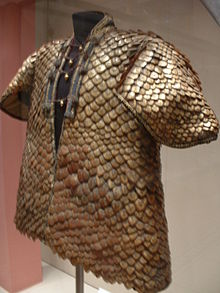This article needs additional citations for verification. (July 2011) |


Scale armour is an early form of armour consisting of many individual small armour scales (plates) of various shapes attached to each other and to a backing of cloth or leather in overlapping rows.[1] Scale armour was worn by warriors of many different cultures as well as their horses. The material used to make the scales varied and included bronze, iron, steel, rawhide, leather, cuir bouilli, seeds, horn, or pangolin scales. The variations are primarily the result of material availability.
Scale armour – a defence of great antiquity – began in the Middle East. The earliest representation is the tomb of Kenamon, who lived in Egypt in the reign of Amenhotep II (1436–1411 BC).[2]
- ^ Armed Batavians: Use and Significance of Weaponry and Horse Gear from Non-military Contexts in the Rhine Delta (50 Bc to Ad 450), Author Johan Nicolay, Publisher Amsterdam University Press, 2008, ISBN 90-5356-253-2, ISBN 978-90-5356-253-6
- ^ H. Russell Robinson, Oriental Armour, Dover Publications, Inc., Mineola, New York, 2002.